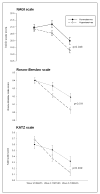Association between concurrent and remote blood pressure and disability in older adults
- PMID: 18025294
- PMCID: PMC2424316
- DOI: 10.1161/HYPERTENSIONAHA.107.097667
Association between concurrent and remote blood pressure and disability in older adults
Abstract
The objective of this study was to investigate the association between blood pressure and disability in older adults. Stroke-free participants in the Charleston Heart Study (n=999, mean age=68.5+/- 0.2 years SE, 57% women, and 39% African Americans) were followed between 1960 and 1993. Functional measures including Nagi's Congruency in Medical and Self Assessment of Disability Scale, the Rosow-Breslaw Scale, and Katz' Activities of Daily Living Scale, in addition to systolic and diastolic blood pressures, were collected in 1984-1985, 1987-1990, and 1990-1993. Additional systolic and diastolic blood pressures from 1960 to 1963 were also available. We defined remote blood pressure change as the change from 1960 to 1984 to 1985 and concurrent blood pressure change as the change from 1984 to 1985 to the follow-up periods. Hypertension was defined as blood pressure >or=140/90 mm Hg or receiving antihypertensive agents, and it was considered uncontrolled if subjects were receiving antihypertensive agents and blood pressure was >or=140/90 mm Hg. Greater increases in remote and concurrent systolic blood pressure increases but not diastolic blood pressure were associated with greater declines in all 3 of the functional measures. Participants with hypertension were also at an increased risk for developing new disability (hazard ratio: 1.28, 95% CI: 1.04 to 1.59 for Nagi scale; hazard ratio: 1.28, 95% CI: 1.02 to 1.59 for Rosow-Breslaw Scale; and hazard ratio: 1.3, 95% CI: 1.01 to 1.69 for Katz scale). Participants with uncontrolled hypertension were at greatest risk of disability compared with normotensive subjects. In stroke-free older adults, increases in remote and concurrent systolic blood pressure increases are associated with greater functional decline. Older adults with uncontrolled hypertension are at a particularly increased risk for disability.
Figures


Comment in
-
Blood pressure and disability: first steps in future studies.Hypertension. 2008 Apr;51(4):e25; author reply e26. doi: 10.1161/HYPERTENSIONAHA.107.109553. Epub 2008 Mar 3. Hypertension. 2008. PMID: 18316651 No abstract available.
References
-
- Tas U, Verhagen AP, Bierma-Zeinstra SM, Hofman A, Odding E, Pols HA, Koes BW. Incidence and risk factors of disability in the elderly: the Rotterdam Study. Prev Med. 2007;44:272–278. - PubMed
-
- Ebrahim S, Wannamethee SG, Whincup P, Walker M, Shaper AG. Locomotor disability in a cohort of British men: the impact of lifestyle and disease. Int J Epidemiol. 2000;29:478–486. - PubMed
-
- Pinsky JL, Branch LG, Jette AM, Haynes SG, Feinleib M, Cornoni-Huntley JC, Bailey KR. Framingham Disability Study: relationship of disability to cardiovascular risk factors among persons free of diagnosed cardiovascular disease. Am J Epidemiol. 1985;122:644–656. - PubMed
-
- Jette AM, Pinsky JL, Branch LG, Wolf PA, Feinleib M. The Framingham Disability Study: physical disability among community-dwelling survivors of stroke. J Clin Epidemiol. 1988;41:719–726. - PubMed
-
- Hajjar I, Kotchen TA. Trends in prevalence, awareness, treatment, and control of hypertension in the United States, 1988–2000. Jama. 2003;290:199–206. - PubMed
Publication types
MeSH terms
Substances
Grants and funding
LinkOut - more resources
Full Text Sources
Medical

